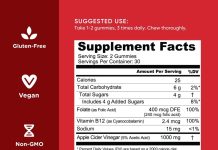Curiosity tends to get the best of us when it comes to our daily calorie intake. We constantly wonder if we’re consuming too much, too little, or just the right amount. Fortunately, there are simple and efficient methods to track our calorie intake throughout the day. By using mobile apps, keeping a food diary, or utilizing a wearable fitness tracker, we can gain a better understanding of our eating habits and make smarter choices to maintain a balanced diet. Let’s dive into the world of calorie tracking and discover how we can take control of our nutritional journey.
Review contents
Understanding Calorie Intake
What are calories?
Calories are a measure of energy. They refer to the amount of energy provided by the food and beverages we consume. Calories come from the three macronutrients – carbohydrates, proteins, and fats. Each gram of carbohydrate and protein provides 4 calories, while each gram of fat provides 9 calories. Understanding calories is crucial for managing our weight and overall health.
Why track calorie intake?
Tracking calorie intake allows us to have an accurate understanding of the amount of energy we are consuming. It helps us make informed decisions about our diet, whether our goal is to lose weight, maintain our current weight, or even gain weight. By monitoring our calorie intake, we can develop healthier eating habits and ensure that we are meeting our nutritional needs.
Recommended calorie intake
The recommended calorie intake varies depending on factors such as age, sex, weight, height, and activity level. The average adult requires around 2000-2500 calories per day to maintain their weight. However, it is essential to consult with a healthcare professional or registered dietitian to determine personalized calorie needs based on individual circumstances.
Factors affecting calorie intake
Several factors influence our calorie intake. These include our basal metabolic rate (BMR), physical activity level, age, sex, and body composition. BMR refers to the number of calories our bodies require to perform basic functions at rest. Physical activity level accounts for the calories burned through exercise and daily activities. Understanding these factors helps us determine our calorie needs accurately.
Methods of Tracking Calorie Intake
Food diary
One of the most common methods of tracking calorie intake is maintaining a food diary. This involves recording everything we eat and drink throughout the day, including portion sizes and preparation methods. A food diary can be a simple notebook or even a mobile app specifically designed for tracking food. It provides a visual representation of our eating habits and allows us to identify patterns.
Mobile apps
With the advancements in technology, many mobile apps have been developed to help track calorie intake. These apps usually have extensive databases of foods and their corresponding calorie values, making it easier to log meals. Additionally, they often provide features such as barcode scanning for quick input and the ability to set goals and track progress.
Online calorie trackers
Online calorie trackers are another convenient way to monitor calorie intake. These websites or platforms offer similar features to mobile apps, allowing us to log our meals and track our progress online. They often provide additional resources such as meal planning tools, recipe ideas, and community support for individuals seeking guidance and motivation throughout their journey.
Wearable devices
Wearable devices, such as fitness trackers and smartwatches, have become increasingly popular for monitoring calorie intake. They not only track physical activity but also estimate calories burned throughout the day. Some devices even have built-in food tracking features or the ability to sync with mobile apps, making it easier to have a comprehensive overview of our calorie intake and expenditure.
Calorie Tracking Techniques
Reading food labels
When tracking calorie intake, reading food labels is crucial. Food labels list the serving size and the corresponding nutritional information per serving. By carefully reading these labels, we can determine the calorie content of the food we consume and make informed choices about portion sizes.
Weighing and measuring portions
To accurately track calorie intake, weighing and measuring portions is highly recommended. Using kitchen scales, measuring cups, and spoons helps ensure our portion sizes align with the stated serving sizes on food labels. This technique minimizes discrepancies and enhances the accuracy of our calorie tracking.
Using calorie databases
Calorie databases, whether online or in the form of mobile apps, are valuable resources for tracking calorie intake. These databases list the calorie content of a wide variety of foods, including both brand-name products and generic options. Utilizing these databases simplifies the process of tracking calories, particularly for foods that do not have pre-packaged labels.
Calculating homemade meals
For homemade meals, calculating calorie intake requires a bit more effort. However, it is still feasible and provides greater control over ingredients and portion sizes. By using recipe calculators or referencing established databases, we can determine the calorie content of each ingredient and calculate the total calorie value for the meal.
Setting Calorie Goals
Determining daily calorie needs
To set appropriate calorie goals, it is essential to determine our daily calorie needs. As mentioned earlier, various factors influence our calorie requirements, such as age, sex, weight, height, and activity level. Consulting with a healthcare professional or registered dietitian can help accurately assess our individual needs and establish realistic calorie goals.
Weight loss goals
For individuals looking to lose weight, a calorie deficit is necessary. This means consuming fewer calories than we burn. A safe and healthy weight loss goal is typically 1-2 pounds per week, which can be achieved by creating a daily calorie deficit of 500-1000 calories. However, it is essential to prioritize nutrient-dense foods and not excessively restrict calorie intake.
Maintaining weight
To maintain weight, our calorie intake should align with our expenditure. This means consuming the same number of calories that we burn. Monitoring calorie intake ensures that we stay within a range that maintains our weight without any significant fluctuations.
Gaining weight
For those aiming to gain weight, a calorie surplus is necessary. This involves consuming more calories than we burn. It is important to focus on consuming nutrient-dense foods to support overall health while increasing calorie intake. Working with a registered dietitian can be beneficial in creating a balanced and effective plan to achieve weight gain goals.
Challenges and Tips for Tracking
Portion estimation
One common challenge when tracking calorie intake is estimating portion sizes when dining out or consuming food without pre-defined serving sizes. To overcome this challenge, visual aids can be helpful, such as comparing portion sizes to common objects or using hand measurements. Practicing portion control at home can also enhance our ability to estimate portions when eating out.
Eating out
Another challenge arises when eating out or ordering takeout, as it can be challenging to determine the exact calorie content of the meals. However, many restaurants and fast-food chains now provide nutritional information, including calorie counts, on their websites or in-store menus. Choosing lighter options, sharing meals, or requesting modifications can also help manage calorie intake in these situations.
Mindful eating
Practicing mindful eating is a valuable technique for tracking calorie intake. This involves being fully present and attentive while eating, focusing on the taste, texture, and satisfaction derived from each bite. Mindful eating can prevent overeating, enhance portion control, and foster a healthier relationship with food.
Accounting for hidden calories
Hidden calories, such as those in condiments, dressings, and cooking oils, can significantly contribute to our overall calorie intake. It is important to account for these hidden calories when tracking our intake. Measuring and tracking the quantity of these ingredients or opting for lower-calorie alternatives can help facilitate accurate calorie tracking.
The Role of Exercise in Calorie Tracking
Tracking exercise-related calorie burn
When tracking calorie intake, it is essential to consider our calorie expenditure through exercise. Many mobile apps, fitness trackers, and even gym equipment are equipped with features that estimate the number of calories burned during physical activity. Tracking exercise-related calorie burn enables us to better understand our net calorie intake and make adjustments if necessary.
Calorie expenditure estimation
Estimating calorie expenditure during exercise can be challenging, as it relies on variables such as body weight, duration, and intensity of the activity. Nevertheless, many online resources provide calculators that estimate calorie burn based on these factors. It is important to keep in mind that these calculations are estimates and may vary between individuals.
Combining calorie tracking with exercise
Combining calorie tracking with exercise allows for a more comprehensive approach to weight management. By monitoring both calorie intake and expenditure, we can fine-tune our nutritional needs and make adjustments accordingly. This integration promotes a balanced and sustainable approach to achieving our health and fitness goals.
Common Mistakes to Avoid
Underestimating portions
One common mistake when tracking calorie intake is underestimating portion sizes. This can lead to consuming more calories than intended. To avoid this, utilizing measuring tools and practicing portion control techniques can help ensure more accurate tracking.
Neglecting liquid calories
It is important not to overlook the calorie content of beverages. Sugary drinks, such as soda and fruit juices, can contribute a significant number of calories without providing much nutritional value. Tracking liquid calories and opting for healthier alternatives like water, unsweetened tea, or infused water can contribute to overall calorie management.
Forgetting to track snacks
Snacks can often be an overlooked source of calories. Remembering to track snacks throughout the day, even if they seem small or insignificant, can provide a more accurate representation of our overall calorie intake. A small snack here and there can add up over time.
Not adjusting for cooking methods
When tracking homemade meals, it is crucial to account for changes in calorie content due to cooking methods. For example, grilling or baking foods typically require less added fat compared to frying. Adjusting for these cooking methods ensures our calorie tracking remains accurate.
Benefits of Tracking Calorie Intake
Increased awareness of food choices
By tracking calorie intake, we become more aware of the nutritional content of the foods we consume. This increased awareness helps us make more informed decisions about our food choices, opt for nutrient-dense options, and prioritize overall health and wellness.
Better portion control
Tracking calorie intake promotes better portion control. By understanding the calorie content of various foods and consistently measuring portions, we can develop healthier eating habits and maintain appropriate portion sizes. This can lead to improved satiety and prevent overeating.
Weight management
Tracking calorie intake is a valuable tool for weight management. Whether our goal is to lose, maintain, or gain weight, monitoring our calorie intake allows us to adjust our habits accordingly. It provides a clear picture of our energy balance and contributes to long-term weight management.
Identifying problem areas
Regularly tracking calorie intake allows us to identify problem areas in our diet. It helps us recognize patterns of overeating, excessive snacking, or consuming calorie-dense foods. By pinpointing these areas, we can make necessary adjustments to better align our eating habits with our health goals.
Integrating Calorie Tracking into Daily Routine
Creating a meal plan
Incorporating calorie tracking into our daily routine begins with creating a meal plan. Planning our meals in advance enables us to allocate and track our calorie intake effectively. By mapping out our meals and snacks for the day or week, we can ensure balanced nutrition and make adjustments as needed.
Prepping meals in advance
Meal prepping is a helpful strategy for individuals tracking calorie intake. By preparing meals and snacks in advance, we have better control over ingredient choices, portion sizes, and overall calorie content. This method also saves time and removes the temptation of reaching for less nutritious options during busy times.
Consistency and accountability
Consistency and accountability are key when integrating calorie tracking into our daily routine. Staying consistent with tracking our calorie intake and being accountable for our food choices helps establish a sustainable habit. Seeking support from friends, family, or online communities can provide additional motivation and encouragement.
Finding a tracking method that suits you
With the various tracking methods available, it is important to find one that suits our lifestyle and preferences. Whether it’s using a mobile app, maintaining a food diary, or utilizing online resources, finding a tracking method that feels comfortable and convenient helps ensure long-term adherence and success.
Sustainable Calorie Tracking Habits
Gradual implementation
To build sustainable calorie tracking habits, it is best to start gradually. Trying to track every single calorie from the beginning may feel overwhelming and unsustainable. Instead, begin with tracking a few meals or specific food groups and gradually expand your tracking to encompass your entire intake.
Seeking professional guidance
For individuals with specific dietary needs or health concerns, seeking professional guidance from a healthcare provider or registered dietitian is recommended. These professionals can provide personalized advice, help set appropriate calorie goals, and provide guidance for long-term success.
Monitoring progress
Regularly monitoring progress is crucial in sustaining calorie tracking habits. This can be done through frequent self-reflection, journaling, or utilizing features available in tracking platforms. Celebrating achievements, identifying areas for improvement, and adjusting goals as needed are all part of the continuous monitoring process.
Maintaining realistic expectations
Finally, maintaining realistic expectations is essential for sustainable calorie tracking habits. It is important to remember that tracking calorie intake is a tool, not a magic solution. It takes time to develop new habits, and there may be occasional setbacks. Embracing a positive mindset and understanding that progress is not always linear will contribute to long-term success.
In conclusion, understanding and tracking calorie intake is a valuable practice for managing our weight and overall health. By utilizing various methods of tracking, implementing effective calorie tracking techniques, and setting appropriate goals, we can develop sustainable habits that support a balanced approach to nutrition. The benefits of tracking calorie intake include increased awareness, improved portion control, weight management, and the identification of problem areas. By integrating calorie tracking into our daily routine, utilizing supportive strategies, and maintaining realistic expectations, we can establish long-term habits that contribute to our overall well-being.



























